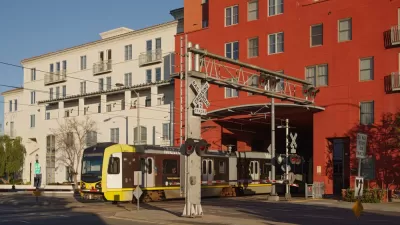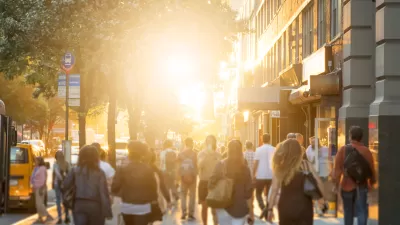Instead of density for density's sake (or for smart growth's sake), F. Kaid Benfield argues that the human scale is the key to walkable smart growth.

F. Kaid Benfield notices that advocacy groups such as Smart Growth America tend to select pictures of historic, mid-density, mixed-use districts when showing the benefits of walkable, "smart growth" cities. According to Benfield, "We use examples like these to illustrate our advocacy because they represent many of the qualities that newer suburban sprawl lacks but that we would like to see in more urban and suburban neighborhoods: walkability, density, and a diverse mix of uses, to name three."
"But I think there’s more going on than that….I submit that a huge reason why people feel attracted to and comfortable in historic neighborhoods is not just because of their familiarity and walkability but also because they present urban density at a human scale."
Rather than focusing just on density as a panacea for suburban ills, Benfield explains that some benefits of more compact living—such as reductions in impervious pavements (in the transportation network serving sprawl) and the use of cars (in the transportation network serving sprawl)—are found at the "lower end of the density spectrum": "the environmental gains begin to diminish at a density of about 20 homes per acre, and there is little additional benefit to these indicators as density increases beyond about 60 homes per acre."
Instead of density as the measure of smart growth and walkability success, or for density's sake, Benfield suggests that urbanists should consider the human scale as promoted by Jan Gehl as critical to the walkability of neighborhoods.
FULL STORY: Remembering the Human Scale in Walkable City Neighborhoods

Trump Administration Could Effectively End Housing Voucher Program
Federal officials are eyeing major cuts to the Section 8 program that helps millions of low-income households pay rent.

Planetizen Federal Action Tracker
A weekly monitor of how Trump’s orders and actions are impacting planners and planning in America.

Ken Jennings Launches Transit Web Series
The Jeopardy champ wants you to ride public transit.

Rebuilding Smarter: How LA County Is Guiding Fire-Ravaged Communities Toward Resilience
Los Angeles County is leading a coordinated effort to help fire-impacted communities rebuild with resilience by providing recovery resources, promoting fire-wise design, and aligning reconstruction with broader sustainability and climate goals.

When Borders Blur: Regional Collaboration in Action
As regional challenges outgrow city boundaries, “When Borders Blur” explores how cross-jurisdictional collaboration can drive smarter, more resilient urban planning, sharing real-world lessons from thriving partnerships across North America.

Philadelphia Is Expanding its Network of Roundabouts
Roundabouts are widely shown to decrease traffic speed, reduce congestion, and improve efficiency.
Urban Design for Planners 1: Software Tools
This six-course series explores essential urban design concepts using open source software and equips planners with the tools they need to participate fully in the urban design process.
Planning for Universal Design
Learn the tools for implementing Universal Design in planning regulations.
Ada County Highway District
Clanton & Associates, Inc.
Jessamine County Fiscal Court
Institute for Housing and Urban Development Studies (IHS)
City of Grandview
Harvard GSD Executive Education
Toledo-Lucas County Plan Commissions
Salt Lake City
NYU Wagner Graduate School of Public Service





























